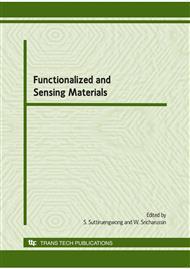p.243
p.247
p.251
p.255
p.259
p.263
p.268
p.272
p.276
Characteristics of Microwave-Esterified Cellulose Film from Corn Husk and Cotton: Effects of Degree of Substitution
Abstract:
The modified cellulose film was synthesized from corn husk and waste cotton fabrics in LiCl/DMAc solvent system by esterification reaction under microwave energy using lauroyl chloride and DMAP as an esterifying agent and a catalyst, respectively. By varying microwave power and reaction time used in the esterification reaction, modified cellulose powder with various degree of substitution (DS) was obtained. The structure of modified cellulose was proved by FT-IR and 1H-NMR analysis. The DS value of modified cellulose was measured by 1H-NMR. The modified cellulose films with different DS values were prepared by casting method. The influences of DS values on the properties of the prepared modified cellulose films were tested for their wettability, water absorption, gloss, and tensile properties. The results showed significant effect of the cellulose source and the DS values on the properties of modified cellulose film. The modified cellulose from corn husk resulted in the film with greater tensile strength and elongation at break than the film from waste cotton fabrics. The esteried-cellulose from both sources with high DS values yielded the film with higher tensile properties and lower water absorption.
Info:
Periodical:
Pages:
259-262
Citation:
Online since:
January 2010
Authors:
Keywords:
Price:
Сopyright:
© 2010 Trans Tech Publications Ltd. All Rights Reserved
Share:
Citation:


